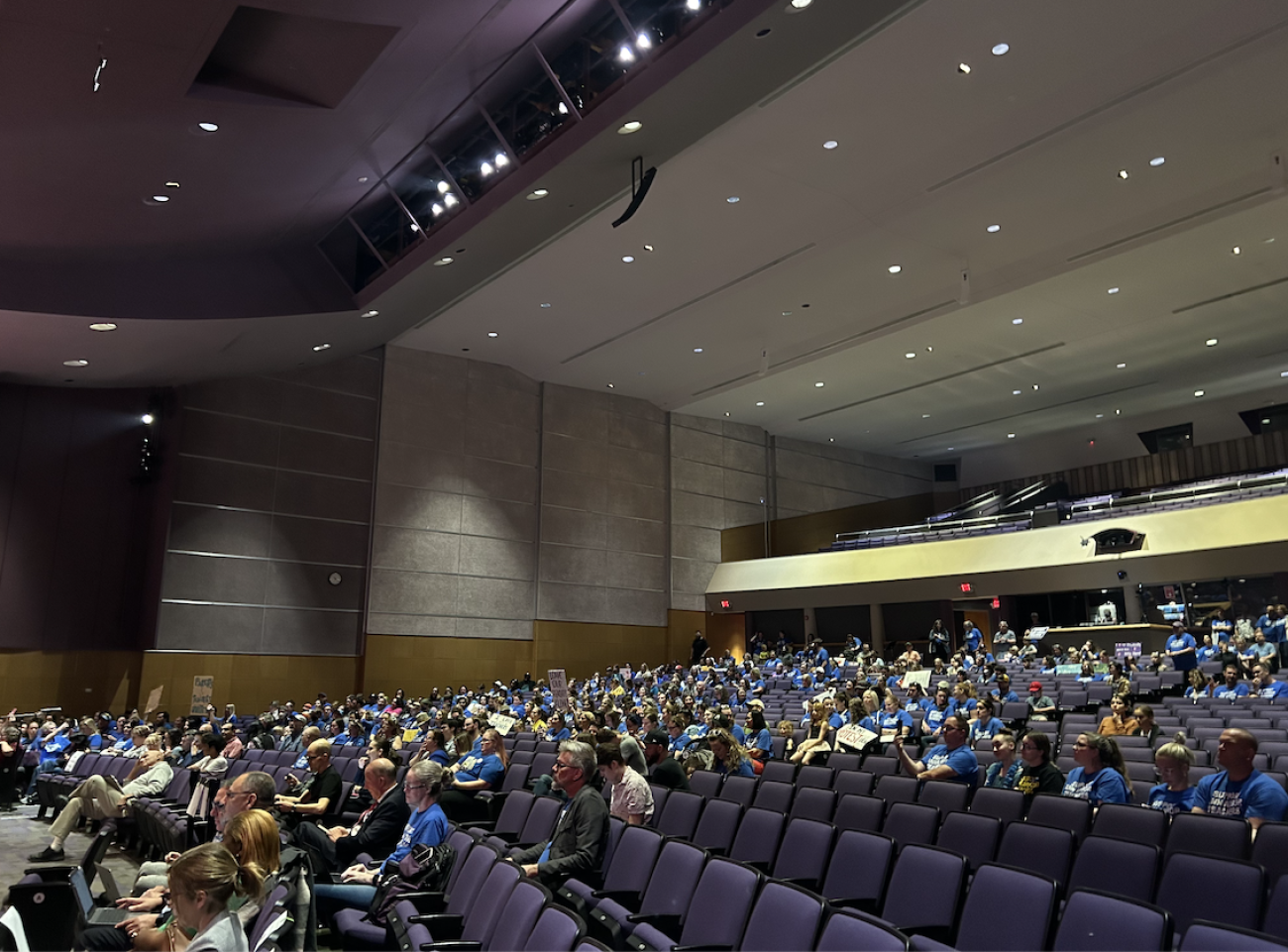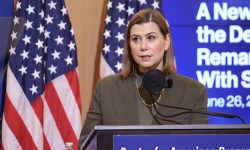Ann Arbor plans teacher layoffs, buyouts as part of $20M in school cuts

- Ann Arbor Public Schools plans teacher layoffs, buyouts and elimination of some programs to cut budget deficit
- The district is also considering selling an administrative building
- Like other Michigan districts, Ann Arbor has suffered enrollment declines in recent years and used up a surge of federal pandemic relief funding
May 21: Ann Arbor Public Schools approves $20.4 million in cuts over parent protests
ANN ARBOR — Ann Arbor Public Schools leaders on Wednesday announced plans to lay off up to 6% of district staff – including 94 teachers – to help resolve a projected deficit.
The $20.4 million cost-cutting plan calls for more than 141 total layoffs, including support staff, paraprofessionals and other district employees.
Officials unveiled the plan Wednesday at a heated school board meeting, where parents and staff in the affluent southeast Michigan community accused the district of financial mismanagement and “negligence.”
Related:
- As ‘COVID cliff’ looms for Michigan schools, Ann Arbor faces cuts, layoffs
- Michigan lawmakers may require high schools to teach computer science
- Amid homeschool boom, Michigan registry fight looms
School board members did not vote on the plan but instead scheduled a Monday meeting to consider potential approval.
“I know that the last few months have been challenging and stressful since we learned of our shortfall,” Interim Superintendent Jazz Parks told board members and attendees at the Wednesday night meeting.
“We do plan to stop here,” she said. “We felt that going any deeper than this at this time, we would begin to strip away at what makes Ann Arbor Public Schools Ann Arbor Public Schools.”
The cost-cutting plan calls for the district to close middle school pools, eliminate world language instruction at most elementary schools and close a virtual elementary school that currently has eight students.
The district also reached an agreement with the teachers union for voluntary buyouts that would pay teachers with 10 or more years of experience in the district with up to $25,000 to resign.
A potential sale
The announcement comes as districts across the state grapple with declining enrollment and prepare to craft new budget plans without pandemic relief funding that had helped close financial gaps but is expiring this year.
Parks first told local families about two months ago that the district needed to make about $25 million in cuts to the 2024-2025 operating budget.
At the time, Parks cited three factors for the budget scenario: increased staffing, decreased student enrollment and higher staffing costs that resulted from “well-deserved and well-earned raises for teachers and staff.”
Marios Demetriou, a retired official re-hired by the district as a school finance consultant, said Ann Arbor will likely still need to identify another $2.8 million in potential cuts to comply with the state’s early warning trigger law.
One option could be to sell property. The district is exploring the possibility of selling an administrative building which could generate “several millions” of dollars in revenue, officials said in a plan sent to the state.
The district will also form an advisory group to “retain and revitalize district enrollment” and advocate for “sufficient school funding” to the state legislature, officials said in the Wednesday presentation.
Details of the cost-cutting plan follow public outcry at previous board meetings, a rally hosted by the teachers' union last week and district-wide events soliciting community feedback about the budget.
On Wednesday, some people wore blue “Support Ann Arbor teachers” shirts and chanted “We want answers!” as they entered Pioneer High School’s auditorium. The teachers union organized a rally ahead of the meeting. Democratic state Reps. Jason Morgan, Felicia Brabec and Carrie Rheingans attended the rally.
Ann Arbor’s plan would cut 6% of the district's 1,457 teachers, along with 19 non-bargained support staff, nine paraprofessionals, three positions in the superintendent's cabinet and other layoffs.
Teacher Maurella Murphy-Morrow, who spoke during public comment and watched part of the meeting from home, told Bridge Michigan she thinks district decisions are “all being made too drastically and too quickly.”
“I'm still left feeling afraid of losing my job, and my husband and I being faced with hard decisions especially as a new mom of a 1-year-old,” she said in a text message of the meeting.
Sarah Shea, a parent of two Ann Arbor elementary students, told Bridge she is “very relieved” that the district chose to continue International Baccalaureate programming but is “still concerned” about layoffs and wonders if more could be done to retain student-facing positions.
Cutting the world language elementary programming is a “big loss,” she said, referring to a proposal the district says would save it $400,000 annually.
Teacher buyouts
Ann Arbor teachers who have ten or more years of service to the district can submit their resignations or retirements to be eligible for one-time payouts under an agreement between the teacher union and the district.
Buyout payments would depend on how many employees step down. If 75 to 99 staff members resign, each would get $15,000 deposited into their retirement account. If 100 to 124 staff resign, each would receive $20,000. If 125 staff members or more resign, each person would receive $25,000.
Under the latter scenario, the district would pay resigned teachers a combined $3.1 million in order to avoid long-term salary costs.
Union president Fred Klein told Bridge that there are roughly 700 district employees who would meet the criteria for the payout. Nothing in the agreement stops resigning teachers from finding jobs in other school districts, he said.
Klein told Bridge the plan to layoff 94 teachers is “alarming,” but hopes the teacher buyout plan could stop more layoffs from happening.
“That’s 94 lives that are going to be disrupted, 94 families that are going to have disruptions,” he said.

Residents spoke out against the pace of potential cuts in an earlier portion of the Wednesday night school board meeting.
“How in the world did this happen,” asked teaching assistant Julie Seadin. “And why are we and all these amazing teachers and paraprofessionals and support staff, why do we have to pay the price for your negligence?”
Seadin told Bridge in a text message she thinks the district “could have done much better.”
She said many teaching assistants have multiple jobs to make ends meet, and she doesn’t “understand how they can say that the students and their education are priority one, yet they cut or reduce valuable curriculum.”
Ann Arbor submitted a plan to the state Treasury Department last month on how it would restore its fund balance back to acceptable levels.
The district said it had identified $4.5 million in central office position savings, is in negotiations to sell a building that “could bring several millions,” and had negotiated savings in contracts with transportation and custodial services.
Parks said the Ann Arbor school board does not technically have to vote on the plan, but she is urging members to do so.
Michigan school districts’ finances
Ann Arbor’s financial situation is somewhat unique, but state officials warn that districts across Michigan are facing a confluence of factors that will make summer budgeting more challenging than the last few years.
Schools are running out of time to spend their federal pandemic relief funds, some have lost funding due to enrollment declines and the state no longer has its own surplus to send them.
That has created what some experts are calling a looming “COVID cliff” for Michigan schools that had relied on a combined $5.6 billion in pandemic aid to balance their budgets.

With local officials set to finalize new spending plans by June 30, state Superintendent Michael Rice this week predicted some districts will face larger challenges than others.
“For some districts, the amount of federal pandemic relief was so high and the need to spend so relatively quick that some districts felt the need to use these nonrecurring revenues for recurring expenditures,” Rice said in a statement.
“Expiration of the funding will be especially difficult for those districts that felt as if they had no other choice than to use some of the funds for recurring expenditures—and didn’t plan or plan well for this moment.”
Ann Arbor received about $27 million in federal pandemic relief funding and has spent nearly all of it, according to the state’s COVID-19 dashboard. The district has added 52 full-time employees since 2019 but lost about 1,100 students.
Some districts made cuts before Ann Arbor.
Last June, Detroit Public Schools Community District board members cut roughly $300 million from its budget, citing enrollment declines and the end of pandemic funds. Wayne-Westland Community Schools last fall announced 39 part-time and full-time layoffs and explored whether to privatize transportation services.
The nonpartisan Citizens Research Council of Michigan has predicted school districts in the state may need to lay off or otherwise cut more than 5,000 teacher jobs in coming years to balance budgets.
Beyond staff reductions, “many Michigan schools may “face the prospect of whether to close buildings … to ensure their long-term fiscal stability,” the council said in a separate report.
Michigan Education Watch
Michigan Education Watch is made possible by generous financial support from:
Subscribe to Michigan Education Watch
See what new members are saying about why they donated to Bridge Michigan:
- “In order for this information to be accurate and unbiased it must be underwritten by its readers, not by special interests.” - Larry S.
- “Not many other media sources report on the topics Bridge does.” - Susan B.
- “Your journalism is outstanding and rare these days.” - Mark S.
If you want to ensure the future of nonpartisan, nonprofit Michigan journalism, please become a member today. You, too, will be asked why you donated and maybe we'll feature your quote next time!






